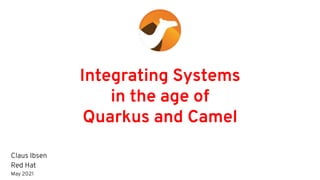
Integrating systems in the age of Quarkus and Camel
- 1. Integrating Systems in the age of Quarkus and Camel Claus Ibsen Red Hat May 2021 September 2020
- 2. About Claus Ibsen ● Senior Principal Software Engineer at Red Hat ● ASF Member & Java Champion ● Apache Camel tech lead ● Author of Camel in Action books ● Based in Denmark ● Blog: http://www.davsclaus.com ● Twitter: @davsclaus ● Github: davsclaus ● Linkedin: davsclaus
- 3. What is Apache Camel
- 4. What is Apache Camel The swiss knife of integration
- 5. What is Apache Camel The giant swiss knife 😅 Packed with a lot of functionality
- 10. Groovy, Kotlin, JavaScript & YAML
- 11. Camel runs on Spring Boot (but not limited to)
- 12. Camel Community ● The biggest and most active community for open source integration software ● 750+ unique contributors ● 14+ years of development and one of the most active Apache projects ● Top 5 ASF projects (number of commits) for three years in a row
- 13. Camel 3 Projects
- 14. Apache Camel 3 - Projects Camel Swiss knife of integration
- 15. Apache Camel 3 - Projects Camel Swiss knife of integration Camel Spring Boot Camel on Spring Boot
- 16. Apache Camel 3 - Projects Camel Swiss knife of integration Camel Spring Boot Camel on Spring Boot Camel Karaf Camel on Apache Karaf / OSGi
- 17. Apache Camel 3 - Projects Camel K Camel on Kubernetes & Knative Camel Swiss knife of integration Camel Spring Boot Camel on Spring Boot Camel Karaf Camel on Apache Karaf / OSGi
- 18. Apache Camel 3 - Projects Camel Quarkus Optimized JVM & Native compiled Java (GraalVM) Camel K Camel on Kubernetes & Knative Camel Swiss knife of integration Camel Spring Boot Camel on Spring Boot Camel Karaf Camel on Apache Karaf / OSGi
- 19. Apache Camel 3 - Projects Camel Quarkus Optimized JVM & Native compiled Java (GraalVM) Camel K Camel on Kubernetes & Knative Camel Swiss knife of integration Camel Spring Boot Camel on Spring Boot Camel Karaf Camel on Apache Karaf / OSGi Camel Kafka Connector Kafka Connector with Camel
- 20. Apache Camel 3 - Latest Project Camel Kamelets Reusable Route Snippets
- 21. Camel Quarkus
- 22. Camel Quarkus brings together the awesome integration capabilities of Apache Camel and its vast component library to the Supersonic, Subatomic Quarkus runtime
- 27. Apache Camel and Quarkus runs extremely fast in JVM mode. Startup is 1.4s (Camel 0.1s), 27mb uber-jar, and 165mb RSS memory used. Compiled with JDK 11.0.7 on Mac OSX
- 28. Apache Camel and Quarkus runs blazingly fast with Native compiled mode. Startup is 28 msec (Camel 5 msec), 54mb binary file, and 31mb RSS memory used. Compiled natively with GraalVM CE 20.3.1 with JDK 11.0.10 on Mac OSX
- 29. Demo
- 32. Camel K
- 33. A lightweight integration platform based on Apache Camel, born on Kubernetes, with serverless superpowers providing Cloud Native Integration capabilities straight from the heart of Kubernetes
- 34. Microservices architecture helps decoupling business domains, but does not helps with coupling with the platform
- 36. Demo
- 38. Kamelets
- 39. Kamelets are Kamel route snippets that allow any user to consume complex actions such as interacting with external systems or executing a set of instructions with a simplified interface, hiding all the low level details.
- 43. Demo
- 44. Low level, Camel programmer
- 47. Demo
- 49. The Kamelet and KameletBinding are good for tooling and UIs as they are discoverable Kubernetes resources with full documentation.
- 51. More Material
- 52. More Material ● Camel website https://camel.apache.org ● Quick Camel K demo (2 min video) https://www.youtube.com/watch?v=I-g2xt-Qcb8 ● Run 100 Camels quickly with Came, Quarkus and GraalVM (10 min video) https://www.youtube.com/watch?v=4lXSf8DBQkQ ● Serverless Integration on Kubernetes with Camel K - KubeCon 2020 (35 min video) https://www.youtube.com/watch?v=beJOCndVfaU ● Awesome Camel K https://github.com/ikwattro/awesome-camel-k ● Camel Tooling Video https://www.youtube.com/watch?v=T26KKY5U-5Q
- 53. Examples ● Camel Examples https://github.com/apache/camel-examples ● Camel K Examples https://github.com/apache/camel-k/tree/master/example ● Camel K Examples (detailed as tutorials) https://github.com/apache/camel-k-examples ● Camel Quarkus Examples https://github.com/apache/camel-quarkus-examples ● Camel Spring Boot Examples https://github.com/apache/camel-spring-boot-examples ● Camel K Chuck Norris Demo https://github.com/ppalaga/camel-quarkus-cnorris-demo
- 54. Any Questions ? https://github.com/apache/camel A star on github is appreciated Thanks to Peter Palaga & Luca Burgazzoli for borrowing many of their slides for this presentation
